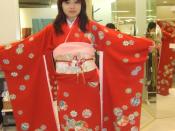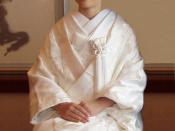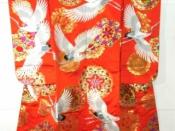Japanese traditional clothing Kimono plays an important rol in the Japanese culyure. different Kimonos are worn during different events by both men and women. However, the traditional clothing of japan mainly focuses on women with different type of kimono representing different stages of the women's life. There are seven types of kimonos that represent different occasions and events, and each has it own representation. The seven kinds of kimonos are Furisode, Yukakata, Houmongi, Uchikake, Tomesode, Hadajuban, and Mofuku which each have their own prpose and meaning.
Kimono meaning the word clothing began in the Heian era(794-1192), and today kimono's meaning is specified as traditional clothing.(Shichi-Go-San). The Japanese culture uses cloting to identify certain stages of a person's life and special occasions and until today this tradition has still not been changed.
Fursode, which is known as the Formal Kimono in japan is worn by young women who have reached the age of 20 representing their adulthood.
Since becoming an adult means they have to become responsible for all their behaviours and actions. To celebrate the young women entering adulthood many parent would buy their daughter a Furisode as a gift. (Kimono encyclopaedia, 2004)
The formal Kimono is for single lasies and it is made of fine silk and usually designed with very long sleeves that could reach all the way to the ground. When a young lady wears her Furisode it is an indication that she is prepared and available for marriage. Furisodes can be worn during weddings and tea ceremonies until the woman is married. A special day for ladies to wear their Furisode in japan is on the second Minday of January, which is a public holiday known as the "adult day" celebrating adulthood.(Kimono Encyclopaedia, 2004)
Kimonos are worn during different times of the year and Yukata is...


